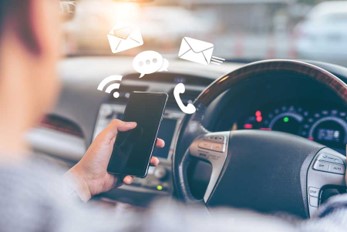5 Distracted Driving Myths: Do You Believe These?
Posted By Darrigo & Diaz

Although you may think you know everything you need to know about driving—hands at 10 and 2, eyes on the road, rearview mirror adjusted—there are a few things that you may want to review. In fact, as far as distracted driving is concerned, the National Safety Council (NSC) estimates approximately 50% of licensed drivers in the United States have misconceptions of what constitutes distracted driving, how risky it can be, and a false sense of security in their ability to multitask.1
We’re debunking some of the biggest distracted driving myths. See if you can get all five right!
Myth #1 – True or False: Drivers can multitask
False! Whether you’re trying to watch TV and check your social media or trying to drive and eat, the brain can’t successfully multitask. It can go from one task to another with lightning speed, but while you’re doing one thing, like eating, you’re not focusing on the other, more important one: driving.
A study by Paris University found that whenever someone tries to complete two tasks, the brain splits in half to accomplish this.2 What we can take from this is – if you are doing any other task besides driving while you are behind the wheel, your brain has a hard time processing these signals and ultimately results in tasks being divided between the two frontal cortexes. In the study, the scientists added another third task to participants and they found that 90% of the participants forgot one of the three tasks they were asked to complete. In conclusion, the human brain is not hardwired to multitask.
Myth #2 – True or False: Talking on the phone to someone is the same as talking to a passenger in your car
False! The University of Utah found that drivers who use their cell phones are more oblivious to changing traffic conditions because they are having a conversation with someone who is not aware of their surroundings.3 However, drivers who are talking to adult passengers in their car have an extra set of eyes and ears to help alert to any oncoming traffic issues. Oftentimes when an adult passenger sees that the driver is concentrating on making a left turn, they become quiet and wait for a better opportunity to continue the conversation.
Myth #3 – True or False: Using your phone at a stop light does not count as distracted driving
False! Even at stop lights, it’s important to remain aware of your surroundings. The American Automobile Association (AAA) conducted a study and found that people who use their phones at stop lights are distracted up to 27 seconds after they finish sending a text.4
In Florida, it is illegal to text while driving, and you can now receive a ticket for doing so. However, the law does not apply to “stationary” vehicles. So, if you are stopped at a red light or in traffic, you can still technically use your phone. Just be mindful of the lingering distraction and try to limit this behavior to only urgent matters.
Myth #4 – True or False: Texting while driving is more dangerous than drinking while driving
True! One study by the National Highway Transportation Safety Administration (NHTSA) concluded that texting while driving is six times more dangerous than driving while intoxicated.5 Other studies have found similar results. Multiple tests have found that drivers in the act of texting had significantly slower reaction times than those who were intoxicated. One study stated that texting drivers react 23 percent slower than intoxicated drivers do.6
Bottomline, you should never drink and drive or text and drive.
Myth #5 – True or False: Voice-to-text is a safe alternative to standard texting
False! Voice-to-text applications do not increase driver safety compared to manual texting. Texas A&M University conducted a study and found that drivers who use voice-to-text are just as distracted as drivers who text, if not more so.7 This is because drivers who use this feature must still manually open the application and many of them feel an inclination to look down at the screen to see if the application heard them correctly. The process of re-reading and proofreading a transcribed text distracts drivers for twice as long than initially texting the message.
Have you been involved in a distracted driving accident in Tampa?
At Darrigo & Diaz, we understand the hardship and loss that is suffered after a distracted driving accident involving serious injury or death. If you or a loved one has been injured in an auto accident, call our Tampa Bay car accident attorneys immediately to ensure your rights are protected. We have represented thousands of satisfied clients in Tampa over the last 20 years and have recovered more than $200 million on their behalf. We handle everything for our clients so you can focus on feeling better.
Get a FREE case review. Contact us online or call today (813) 774-3341
